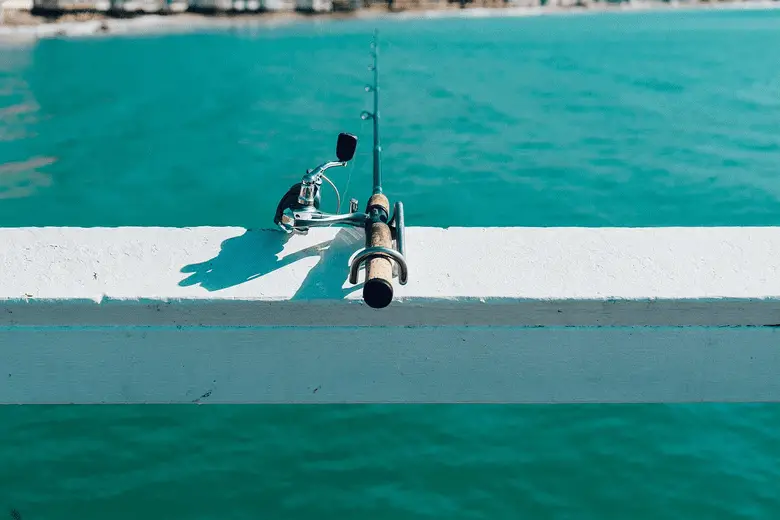Copolymer fishing line is made with a combination of two types of nylon. Copolymer takes the best properties of mono and fluoro combining them into a high-performance nylon fishing line.
It’s not a twin-strand, braid-style fishing line, weaving a single strand of mono and a single strand of fluoro.
It’s traditional monofilament ingredients with fluoro coatings or infusions, creating a single-strand nylon line. Put simply, if confusingly, it’s a monofilament – with a difference.
For those familiar with the performance qualities of mono and fluoro, you could imagine that taking the best performance properties of each might provide superior performance.
Is copolymer the future of nylon single-strand fishing lines? Let’s take a closer look at copolymer fishing line.
Maybe it’s all you ever wanted in a mono.
Page Contents
What Are The Benefits of Copolymer Fishing Line?
Low Memory
Copolymers have a low memory compared to mono and fluoro. This means copolymer will retain far less spool shape, which has significant advantages for the reduction of loop Knots and other tangles.
While there are memory variations between brands and models, both mono and fluoro will retain the loop shape of a spool arbor.
When casting, loops can peel off in a bunch, creating all sorts of tangle issues.
A copolymer fishing line mitigates this all too common problem. Like braid, it’s far more relaxed and less inclined to bend, hold kinks, and shape.
Lower Stretch
Mono is high stretch, fluoro has a moderate level of stretch, with braid having virtually none.
Copolymer has some stretch but less than mono and fluoro while having more than braid.
Most anglers have different preferences for fishing line stretch.
High stretch offers significant forgiveness, with less stretch offering significant advantages for sensitivity hook-setting.
Copolymer offers a sensible balance.
It’s great for anglers of all skill levels, as there’s a level of stretch and therefore forgiveness. A heavy strike is less likely to pull hooks or snap light lines.
Copolymer, with a modest level of stretch, delivers significant sensitivity benefits to other nylons.
More Sensitive
Due to its extra sensitivity, copolymer is an ideal choice for lure anglers or when fishing locations with shy or timid fish.
Essentially, the angler can feel more of what’s happening under the water.
You can feel the structure, lake bed contours, and current. You can also feel fish making shy inquiries at your bait.
More sensitive lines offer advantages for lure performance as well.
Fishing line selections that are supple and sensitive create better action for all lures and present all bait types in a natural manner.
Copolymer offers a higher sensitivity to mono and fluoro yet is not as sensitive as braided fishing lines.
Better Strength to Diameter Ratios
You will often hear it said that “braid is strongest” or “copolymer is stronger.” This is inaccurate. 10-pound line is 10-pound line, no matter what it’s made from.
Regardless of its composition, a fishing line rated to 10 pounds will likely break soon after this 10 pounds of strain is exceeded.
What “stronger” means is that certain lines have a greater strength-to-diameter ratio. For example, 6-pound mono is on average a third thicker than 6-pound braid.
There are several benefits to using the thinnest line diameters possible.
They include greater casting distances and accuracy, more line on the spool, better lure performance and bait presentation.
Copolymer has a better strength-to-line diameter ratio than mono and fluoro but it’s not as thin as braids.
Many anglers who use mono have taken to copolymer based on its strength to diameter ratio alone – it’s one of its most compelling features.
Variety of Compositions
Not all copolymers are the same. For that matter, not all fluoros, braids, or monos are the same.
Different manufacturers create a number of lines that focus on certain performance properties.
Some lines will focus on greater abrasion resistance, others focus on line roundness or smoothness.
Copolymers are the same in this regard.
Always check the manufacturer’s specifications to see if there’s a line property or feature that’s better suited to your particular fishing application.
What Is the Difference Between Copolymer and Monofilament Fishing Line?

There’s an argument that the average weekend angler wouldn’t know they were using copolymer if they weren’t told.
However, If you are to compare the two, you can see and feel the difference.
Copolymer is thinner than mono, to begin with, and it also feels more supple in some cases.
Knots can be tightened pretty easily. With the absence of line memory, knots are just a little bit easier to tie.
Because the line diameter is thinner, you’ll definitely get a surprise when you cast it. Expect more distance.
Copolymer is buoyant but does eventually sink. It doesn’t absorb water like mono.
It’s great for fishing deeper in the water column and using suspended baits. However, most will find it’s great for fishing the top water.
Another difference you’ll notice straight away is that copolymer is almost certainly going to cost you a lot more money.
How Does it Compare to Braided and Fluorocarbon Line?
I can’t say that I’ve fished on the water doing a direct comparison in any sort of scientific way.
This would be the only way I could give an accurate performance comparison between copolymer, braid, and fluoro.
The biggest difference is the obvious material and construction difference between braid and copolymer – they’re completely different line types.
One is a mono, the other a multistrand.
Copolymer does, however, pick up the sensitivity benefits of fluoro and braid. It is also thinner than fluoro, while not quite as thin as braid.
I think of it like this.
If you shy away from braid because it’s so unforgiving; if you don’t like the hardness of fluoro; Copolymer delivers a happy balance, that will appeal to lure and bait anglers alike.
Being the less-than-cautious knot tier that I am, I prefer tying knots with copolymer over braid.
It’s a minor consideration, yes. But copolymer is just easier, and in that regard, the average angler is likely to tie more reliable knots using copolymer.
Frequently Asked Questions
Is Copolymer Line Stronger than Mono?
10 pound breaking strain is 10 pound breaking strain, regardless of the fishing line type.
The difference is that copolymer fishing line has a thinner diameter than mono, for the same test weight.
How Good Is Copolymer Fishing Line?
This is a difficult question to answer. Firstly, there are many variables to consider, such as the performance characteristics of different brands – not all copolymers are the same, nor do they deliver the same performance.
Secondly, rating something as good or otherwise can be very subjective. For example.
Some may like copolymer, but not enough to spend the extra money. They don’t believe the benefits are commensurate with the price point.
For others, certain copolymers are absolutely perfect for their fishing application. They feel it gives them an edge over other line types.
The only way to assess the performance of copolymers is to try a few brands for yourself.
I think you’ll enjoy the discovery process, and it’s definitely worth the extra coin to check them out. You might find it’s perfect for you.
Does Copolymer Line Sink or Float?
Anglers often get a little mixed up with the terms, floating, sinking, suspending, etc.
And I have to say (unfortunately) that I’m guilty of not explaining fishing line buoyancy with the accuracy it requires.
A boat floats, and polystyrene floats. Fishing lines sink, float, and suspend, but all will eventually sink.
Fly line, however, can do both. I like to think of it like this; They all sink, but at vastly different speeds.
Eventually, everything sinks.
Adding lures, sinkers, and baits of different weights and buoyancies can completely negate fishing line and buoyancy and sink rates.
For example, put a half ounce of lead on your line, and it really doesn’t matter – the line will sink.
Braided line is buoyant, but will sink eventually. Mono has neutral buoyancy and will eventually sink. Fluoro will sink faster.
Copolymers also sink, but at different rates depending on the brand and make.
When you’re fishing high in the water column or fishing the top water, look for a line with maximum buoyancy and slow sink rates.
Wanna fish deep? Look for faster sink rates. It’s that simple…sort of.
Truth is, most weekend anglers won’t even know or care. Give everything a try, and fish the line you’re most comfortable with.
Sharing is caring!
